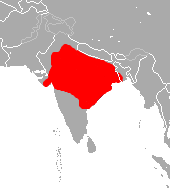Bengali Hanuman Langur
| Bengali Hanuman Langur | ||||||||||||
|---|---|---|---|---|---|---|---|---|---|---|---|---|

Bengali Hanuman Langur ( Semnopithecus entellus ) |
||||||||||||
| Systematics | ||||||||||||
|
||||||||||||
| Scientific name | ||||||||||||
| Semnopithecus entellus | ||||||||||||
| ( Dufresne , 1797) |
The Bengali Hanuman langur ( Semnopithecus entellus ) is a primate species from the slender monkey group and is one of the six species into which the subgenus Hanuman langur within the genus of Indian langurs ( Semnopithecus ) is divided in more recent classifications.
features
Like all Hanuman langurs, they are slender, long-tailed animals. The head-torso length of adult animals is between 45 and 78 cm and the tail is between 80 and 112 cm long. Male monkeys can weigh 16.9 to 19.5 kg, while females are considerably lighter at 9.5 to 16.1 kg. The fur is predominantly yellowish-orange in color. The back and limbs are gray-brown and the hands and feet are black. The hairless face is also colored black and has the bulges over the eyes typical of the species.
distribution
Bengali Hanuman langurs are among the most widespread and common Hanuman langurs. Their distribution area covers the entire north Indian lowlands and a small area in the southwest of Bangladesh . In the southwest of the distribution area in the Indian state of Gujarat they occur south to the Tapti , in the southeast to the Krishna . The southern limit of its range coincides with the southern limit of the range of the rhesus monkey ( Macaca mulatta ) in India.
Bengali Hanuman langurs are not fussy about their habitat and are found in forests and tree-lined bushlands as well as near human settlements. Today most of them live in landscapes that were shaped by humans, the rest mainly in tropical, dry deciduous forests, in Gujarat and Rajasthan also in thorn forests and on the eastern and southeastern edge of the distribution area in tropical wet forests. As a lowland species, they only occur up to heights of 400 meters and are replaced by the Tarai Hanuman langur ( S. hector ) in the Terai on the northern edge of the distribution area and by the black-footed Hanuman langur ( S. hypoleucos ) on the southwest edge at the transition to the Deccan .
Way of life
They are diurnal and can live both in the trees and on the ground. They mostly live in harem groups, which consist of a male, several females and their offspring. Sometimes mixed groups (several males and females) also occur; the remaining males often form bachelor groups. They are mainly herbivores and eat leaves, fruits, buds, bark and grasses, but sometimes also insects. (For more details, see the way of life of the Hanuman langurs .)
Danger
The loss of habitat represents the greatest threat to these primates. However, due to their large range, they are not yet endangered.
Systematics
In the past, all gray Hanuman langurs were grouped into one species, which also bore the scientific name Semnopithecus entellus . After the division of the gray Hanuman langurs into six species, which has not yet been recognized everywhere, these are only used for the species found in the north Indian lowlands.
literature
- Thomas Geissmann : Comparative Primatology. Springer-Verlag, Berlin et al. 2003, ISBN 3-540-43645-6 .
- Don E. Wilson , DeeAnn M. Reeder (Eds.): Mammal Species of the World . A taxonomic and geographic Reference. Johns Hopkins University Press, Baltimore MD 2005, ISBN 0-8018-8221-4 .
supporting documents
- ↑ a b c D. Zinner, GH Fickenscher & C. Roos: Family Cercopithecidae (Old World monkeys). Page 733 in Russell A. Mittermeier , Anthony B. Rylands & Don E. Wilson : Handbook of the Mammals of the World: Primates: 3rd ISBN 978-8496553897
- ↑ Semnopithecus entellus in the IUCN Red List of Endangered Species . Retrieved April 19, 2009.
